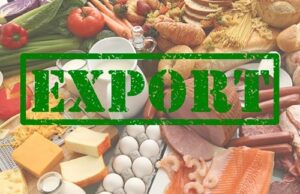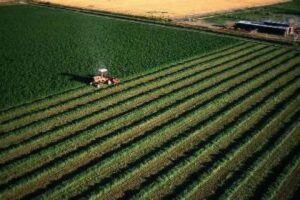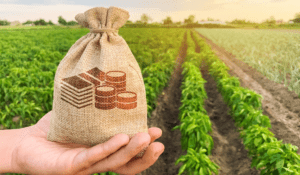
Ukraine and Egypt are considering the realization of joint logistics projects in agriculture, in particular the creation of a logistics hub in Egypt for supplying Ukrainian grain.
As reported on the website of the Ministry of Agrarian Policy and Food, the relevant agreements were reached during the meeting between the head of the Ministry Nicholas Solsky and Ambassador Extraordinary and Plenipotentiary of the Arab Republic of Egypt to Ukraine Ayman Ahmed Mukhtar Elgammal.
“They paid special attention to the detailed discussion of the possibility of expanding trade relations between Ukraine and Egypt and deepening cooperation in the agricultural sector. Mr. Ayman Ahmed Mukhtar Elgammal expressed Egypt’s interest in the implementation of joint agricultural logistics projects. We are talking, in particular, about the creation of a logistics hub for grain supplies. Mykola Solskyy noted that Ukraine will consider Egypt’s proposal,” – was stated in the report of the Ministry of Agrarian Policy.
Also during the meeting, the parties discussed the implementation of the humanitarian initiative Grain from Ukraine and Ukraine’s role in ensuring food security of the world.
As reported, a similar desire to build hubs for the importation of Ukrainian agricultural products expressed Senegal, Nigeria and Ghana during the visit of delegations of the Ministry of Agrarian Policy to African countries in January 2023.
The State Agency for Food Purchasing of Egypt (GASC) purchased 60 thousand tons of corn of Ukrainian origin on February 6. The agricultural products were purchased from the operator Egyptian African Co in two batches of 30,000 tons each at a price of $323/ton.

On September 15, the Ministry of Agrarian Policy and Food of Ukraine signed a memorandum of cooperation with one of the world’s largest databases, AgroChart, containing information on prices and statistics of agricultural markets since 1970.
As reported on the agency’s website on Friday, the signing of the document will provide the Ukrainian agro-industrial complex with up-to-date information on the Ukrainian market situation, assessment of export opportunities and tracking changes affecting the export and import of Ukrainian agricultural products.
“Today, more than ever, it is important to provide our farmers with reliable information about the functioning of the markets for grain, oilseeds and feed ingredients, up-to-date analytics of export supply and import demand by country, prices, etc. All this will help them make informed decisions,” – the words of the Deputy Minister of Agrarian Policy for Digital Development, Digital Transformations and Digitalization Denis Bashlyk are quoted in the message.
He said that in the future it is possible to integrate AgroChart databases with the State Agrarian Register (SAR), but this will not happen in the near future.

Foreign exchange earnings from the export of agricultural products from Ukraine from March to May, during the three months of the war with the Russian Federation, are approximately comparable to the export figures for one pre-war month, Minister of Agricultural Policy of Ukraine Mykola Solsky said in an interview with AgroPolit.
According to him, in January 2022, Ukraine exported agricultural products worth $3.14 billion, in February – $2.54 billion, in March – $0.84 billion, in April – $0.9 billion, and in May – $1.21 billion.
“We see that foreign exchange earnings from the agro-industrial complex during the war fell threefold … That is, in March-May, agricultural exports amounted to $ 2.95 billion, while this was the traditional amount for one month (before the full-scale invasion of the Russian Federation – IF-U)”, Solsky emphasized.
As reported with reference to the Deputy Minister of Economy – Trade Representative of Ukraine Taras Kachka, Ukraine in the 2021/2022 marketing year (MY) exported 61.52 million tons of grain and oilseeds worth $22.2 billion.
According to him, wheat exports amounted to 18.7 million tons worth $4.8 billion, corn – 23.54 million tons worth $5.8 billion, barley – 5.74 million tons worth $1.3 billion.
Kachka added that the export of 4.3 million tons of sunflower oil brought $5.8 billion, 3.4 million tons of sunflower meal – $960 million tons and 421 thousand tons of soybean meal – $230 million.
According to him, 1.1 million tons of soybeans for $641 million, 2.7 million tons of rapeseed for $1.7 billion and 1.09 million tons of sunflower seeds for $616 million were also exported.
AGRO-INDUSTRIAL COMPLEX, EARNINGS, EXPORT, FOREIGN EXCHANGE, PRODUCTS

The Ukraine Recovery Plan for 2022-2032 includes a number of projects in the agro-industrial complex, the implementation of which will require an investment of at least $37 billion, including a project for the development of processing in the agricultural sector in accordance with the Green Deal principles, for which it is planned to raise $10.2 billion.
It is proposed to increase the production of starch, syrups, gluten, lecithin, protein, premixes, meat and milk as the key directions for the development of processing in the agro-industrial complex, according to a detailed document provided to Interfax-Ukraine by Secretary of the National Council for Ukraine Recovery Danylo Hetmantsev.
It is also planned to attract $4 billion of investments in the construction of an irrigation system on a total area of 1 million hectares, $7.7 billion in increasing the production of agricultural products with high added value, $1.6 billion in the reclamation of war-damaged lands, $5.5 billion in increasing livestock production and $1 billion to promote the transition of the Ukrainian agro-industrial complex to “green” development.
According to the document, it is planned to attract $6.5 billion by 2032 to restore 10,500 Ukrainian agricultural enterprises after the war.
The plan for the recovery of Ukraine specifies that the main problems of the Ukrainian agro-industrial complex are the low degree of agricultural products processing, the generation of insignificant amounts of surplus value by the agricultural sector, and the country’s dependence on “oversized imports.”
As reported, the Ukraine Recovery Plan is aimed at accelerating sustainable economic growth. The plan defines a list of national programs to achieve the key results.
In total, the program provides for the implementation of 850 projects during 2022-2032, which will allow Ukraine to enter the TOP-25 countries in the world in terms of the Human Capital Index and the Economic Complexity Index.

The plan for the restoration of Ukraine in 2022-2032 includes a number of projects in the field of agro-industrial complex, including the construction of irrigation systems on an area of 1 million hectares, as well as the transformation of the country into an “export food factory” by stimulating and developing the processing of plant products.
The corresponding plans were posted on the Ukraine Recovery Plan website.
In addition, over the next decade, it is planned to develop the Ukrainian agro-industrial complex in the following areas: development of agricultural engineering, bioenergy independence, preservation of the agricultural sector under the blockade of ports, meat and dairy independence, fruits and vegetables of Ukraine, return of farmland into economic circulation, promoting the transition of the agro-industrial complex to “green” growth, development of reclamation systems, development of seed production, construction of factories for the production of hybrid seeds and prompt recovery of the agro-industrial complex after the war.
In addition, among the priorities are the comprehensive planning of spatial development and land use in the territory of communities and mapping the territory of Ukraine and the implementation of the national geospatial data infrastructure.
According to the data on the project website, the Ukraine Recovery Plan is aimed at accelerating sustainable economic growth. The plan defines a list of national programs to achieve key results.
In total, the program provides for the implementation of 850 projects during 2022-2032, which will allow Ukraine to enter the TOP-25 countries in the world in terms of the Human Capital Index and the Economic Complexity Index.

The total amount of indirect (indirect) losses inflicted on the agricultural industry of Ukraine as a result of the full-scale invasion of the Russian Federation amounted to $ 23.3 billion for the period from February 24 to June 9, while the country suffered the largest losses (51%) due to the blockade of its seaports to reduce the cost of agricultural products – $ 11.9 billion.
The relevant data was published on Wednesday in the analytical study “Overview of indirect losses from the war in agriculture in Ukraine”, prepared by the Center for Food and Land Use Studies of the Kyiv School of Economics (KSE Institute) in cooperation with the Ministry of Agrarian Policy and Food of Ukraine.
The organization recalled that the day before it presented a study estimating the direct losses of the agro-industrial complex of Ukraine due to Russian aggression at $4.3 billion. According to the document, direct losses reflect the complete or partial destruction of tangible assets, while costs that producers are forced to bear because of the war.
It is noted that half of the indirect losses of the Ukrainian agro-industrial complex fell on the reduction in the cost of agricultural products due to its accumulation in the country caused by the blockade of Ukrainian seaports by the Russian fleet – $ 11.9 billion. Other factors were the reduction in crop production – $ 9.6 billion (43% of total losses) , an increase in the cost of production factors – $ 0.86 billion (4%), a reduction in the livestock sector – $ 0.68 billion (3%) and a reduction in the yield of perennial crops – $ 0.09 billion (> 1%).
“Due to the blockade of ports by the Russian Navy, Ukraine faced an oversaturation of the domestic market of export-oriented products and an almost fourfold increase in the cost of export logistics. This led to a decrease in prices within the country for the main export-oriented crops by more than 30%,” the statement says. in the KSE study.
As an example, the organization cites food wheat, the price of which in Ukraine on the terms of EXW (self-delivery) during the war with the Russian Federation decreased by 35% – from $297/ton to $192/ton, while over the same price period the world price for it increased post twice.
According to the study, the reduction in the wheat crop in 2022 is expected to be 33% compared to the baseline scenario, which corresponds to $2.03 billion of indirect losses, the reduction in the sunflower crop – 32% ($2.43 billion of indirect losses), barley – 31% ($0 .56 billion), corn – 18% ($1.29 billion). Lost income due to a reduction in the harvest of other crops is estimated at about $3.3 billion.
“With the start of the Russian invasion, Ukrainian agricultural producers also faced higher cost of production factors, including higher prices for fertilizers and fuel. The cost of fertilizers has increased by 37% since the beginning of the Russian invasion, while the price of diesel fuel has increased by about $0.39/liter. Total losses due to increased production costs are estimated at $859 million,” KSE stressed in the study.
According to her, the losses due to the reduction in the yield of perennial crops in 2022 are estimated at $89 million. Considering that it takes an average of five years before the fruiting period of new perennial plantations, indirect losses from the destruction of perennial plantations will amount to $222.4 million over five years.
“Calculation of indirect losses helps to understand not only the scale of the industry’s decline, but also the need for a full resumption of production. A significant part of the lost income was used to cover the costs of the subsequent sowing campaign and the purchase of feed for livestock. Without partial compensation for losses, farmers in the regions most affected by war, will not be able to resume production,” KSE quotes its expert Roman Neiter.